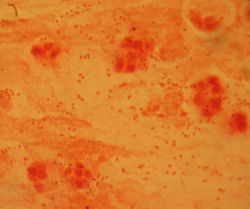Haemophilus species - Overview
| Haemophilus | |
|---|---|
| Phylum | Proteobacteria |
| Class | Gamma Proteobacteria |
| Order | Pasteurellales |
| Family | Pasteurellaceae |
| Genus | Haemophilus |
Overview
The Haemophilus species inhabit the mucosal epithelium of the upper respiratory and lower genital tract. They cause suppurative infections due to the release of pro-inflammatory cytokines, released from macrophages. This includes serofibrinous to fibrinopurative infections of the lungs, body cavities and joints. The colonisation of meningeal vessels causes a thrombotic vasculitis leading to encephalitis and meningitis.
Characteristics
Haemophilus species are morphologically variable Gram-negative bacilli, ranging from short rods to long filaments. They are facultative anaerobes and are typically oxidase positive. They depend on beta-nicotinamide adenine dinucleotide (NAD) (V factor) and/or Haemin (X fector) for growth.
Heated blood agar (Chocolate Agar) is required for growth of NAD-dependent strains. Haemin-dependent strains grow on Blood Agar but do not grow on MacConkey agar.
See here for a list of Haemophilus species
| This article has been peer reviewed but is awaiting expert review. If you would like to help with this, please see more information about expert reviewing. |
Error in widget FBRecommend: unable to write file /var/www/wikivet.net/extensions/Widgets/compiled_templates/wrt662296c1df4c63_90888881 Error in widget google+: unable to write file /var/www/wikivet.net/extensions/Widgets/compiled_templates/wrt662296c1e28904_30866356 Error in widget TwitterTweet: unable to write file /var/www/wikivet.net/extensions/Widgets/compiled_templates/wrt662296c1e576e9_93728412
|
| WikiVet® Introduction - Help WikiVet - Report a Problem |
